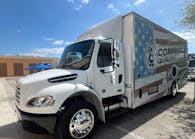Cordless power tools have come a long way since the days of nickel cadmium (NiCd) battery packs. While those batteries may still be used for some DIY home applications, any cordless tool found in a professional repair shop will likely operate with a lithium ion battery.
Advancements in battery technology have allowed manufacturers to provide more power in the same size, or smaller, battery pack; longer operating time on one charge, and faster charging capabilities.
“The batteries are just lasting a lot longer (and) the warranty is better on the batteries,” says Oklahoma City-based Mac Tools distributor Shawn Stahle. “They’re lighter, more compact. There are just so many good things with the new technology and the batteries where (customers) just really like the cordless lines.”
Better batteries
Within the last five years or so, the industry has seen increased advancements with battery technology.
“The battery technology – lithium ion – is getting to be just as powerful as pneumatic tools,” says Milton Fang, Director of Sales and Marketing, Durofix, Inc. “In a shop environment, cordless tools are especially suitable because the tools aren’t being used continuously, over hours at a time, compared to say, a construction site.”
“Most of the time, (cordless tools are) used in short bursts measured in seconds, and then repeatedly used. For usage time, you can pretty much use the same tool without changing the battery for the whole day, for the same jobs you’d use pneumatic with anyway,” Fang adds.
Regardless of how long the battery will last – whether it be half a day, or a week, depending on application – it will have to be recharged.
Many manufacturers offer fast charging systems, to allow for an expedited battery charge in as little as 30 minutes.
“We will continue to see the advancement of battery technology as an industry trend over the next couple of years, as (batteries) get lighter, better and more cost-efficient,” says Beth Bjorlo, Global Portfolio Leader, Vehicle Service Power Tools, Ingersoll Rand.
New tool features
Last year, DeWalt launched a new FlexVolt line of tools. This battery is constructed to provide either 20V or 60V output. Depending on the tool attached, the output will automatically adjust. A popular tool with field techs, the battery associated with the DeWalt 60V 4” grinder can then be used with any other DeWalt 20V tool platform.
This 60V 4” grinder is just awesome,” says Chris Carlson, a Mac Tools distributor out of Midland County, Texas. “I’ve been getting a lot of good feedback on the 60V products from DeWalt. The longevity of the battery, they feel like they’re getting more power out of it.”
MacTools’ Stahle also confirms the DeWalt FlexVolt line has been well-received. “The cordless grinder available I’ve sold to my welders that are in the field, or welders who just want to grab it and do some grinding. They love it because they don’t have to mess with a cord and a generator and all that other stuff that goes with it. Then they can turn around and put that on a 20V, 1/2" impact and use the same battery platform.”
Speaking of compatible batteries, Milwaukee tool has been on the same 12V platform (M12) and 18V platform (M18) for nearly a decade. This allows users with new batteries to use them on older Milwaukee tools, or to use new tools with older Milwaukee batteries.
“Say a user bought a tool back in 2008, it will work with the batteries we’ve launched this year. And vice versa – if you had a battery back from 2008, it will work with any M18 tool that we’ve launched this year. Same goes for M12 system,” says Eric Rusch, Senior Product Manager, Milwaukee Tool.
Better warranties
When a customer purchases a product off the tool truck, he or she will likely ask about the warranty.
Manufacturer warranties for cordless tools range anywhere from one to five years. The battery is usually a separate warranty from the tool.
“Users see a ton of value in that because they’re using these tools all day, every day,” says Milwaukee Tool’s Rusch. “They’re putting these tools to the test and to their limits, so they want to have the confidence that if something does go wrong, they’ll want to be taken care of.”
Brushless motors
Many cordless tools have shifted to implementing brushless motor technology into their tools, for added efficiency and performance over brushed motors.
“What this technology gives us is a much more reliable motor, extended usage time on one charge and more power in general. Because of not needing to use a brushed motor to have it spin, it’s a different type of magnetic technology,” says Fang.
In addition to the better tool performance, brushless motors are touted as safer to use.
“With the brushed motor, you could potentially get sparks, and that’s not good in a dusty and flammable environment,” says Fang. He adds brushless motors generate less heat if the tool is in operation for a longer period of time (over one minute of operating time).
Multiple torque settings
A number of tool manufacturers offer advanced features on tools to aid in making technicians more efficient by allowing users to dial in specific torque settings.
Last year, Ingersoll Rand introduced the W5132 3/8” Impact featuring the company’s IQv Power Control System. This system features four modes, adjustable by a simple dial on the back of the tool head, to select a specified range of torque. The four modes include: full power, mid power, wrench tight and hand tight.
Similarly, companies like ACDelco and Milwaukee Tool offer specified pre-set torque options.
Specifically, ACDelco offers its Electronic Torque Control technology on some tools, allowing the technician to enter in a numerical torque value on the tool. Once the tool is in use and applies the specified amount of torque, the tool will stop.
In addition to helping track and manage inventory, and report the locations of tools, the Milwaukee Tool One-Key will also allow users to set specific torque settings on the tool.
“One-Key allows users to have more control over the output of the tool. If they want to be very precise or delicate with fasteners, without worrying about torqueing out or snapping the head off, it allows the users to control the output of the tool so they can have the confidence in knowing they’re not going to over torque those fasteners,” says Rusch.
This pre-set torque functionality will only be available on Milwaukee Tools with One-Key going forward (it does not have retrofit capabilities). It works by interfacing with the corresponding smartphone app to customize up to four pre-set torque settings, saved right onto the tool.
What’s on the horizon?
The increased adoption of cordless tool technology has also spurred the development of other tools and equipment in the shop. With the increased use of these tools, technicians need a way to charge these products – oftentimes right in the bay for efficiency. Tool storage solutions have evolved to include power at the storage source – including 110V plugs, as well as USB ports for charging personal devices.
Manufacturers will continue to think of new and innovative ways to improve the use of their tools.
Along with smartphone integration, cordless power tools will continue to see advancements in battery technology, overall performance and new features to help technicians work safely and more efficiently.



